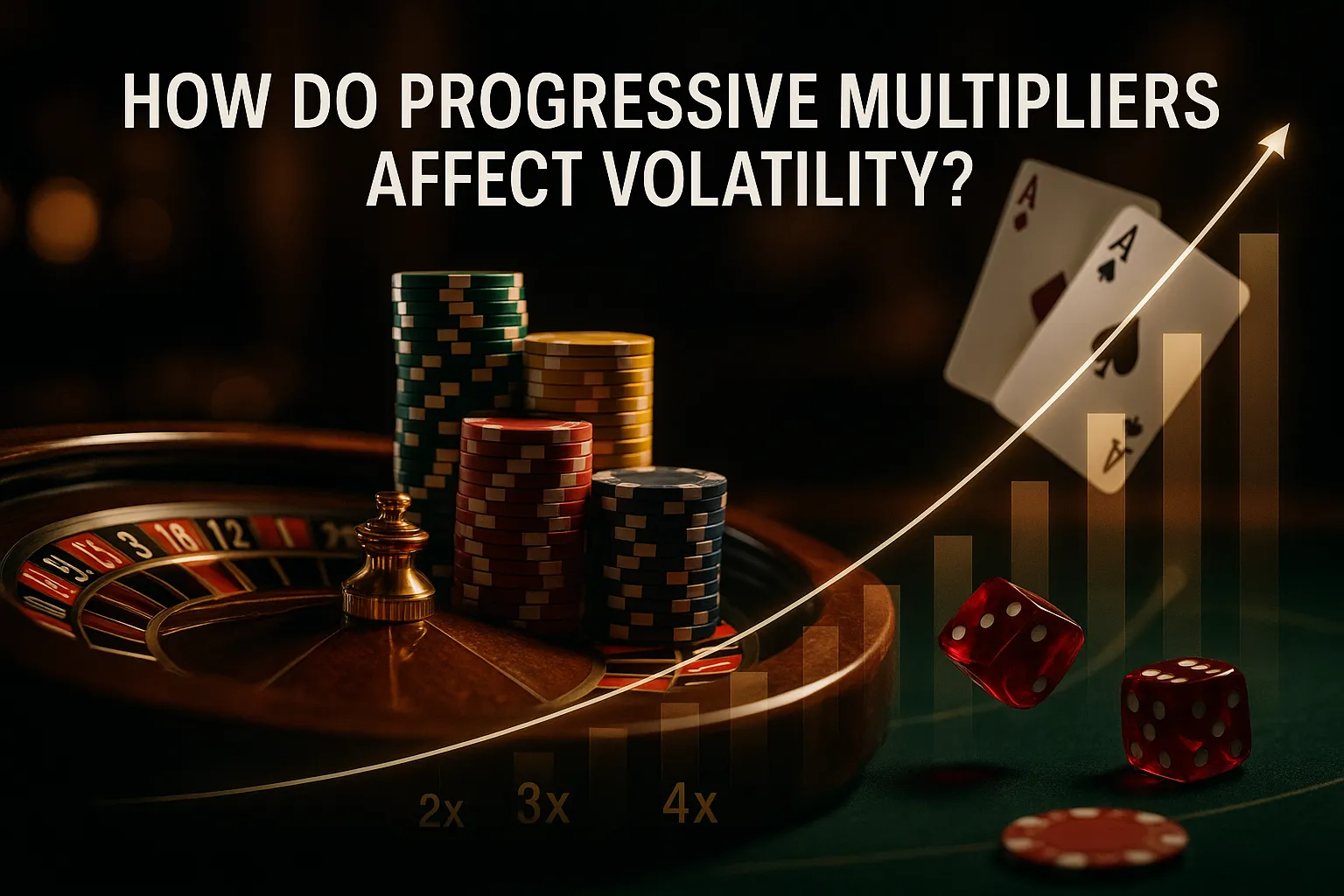When I first encountered a slot game advertising “progressive multipliers,” I’ll admit I was skeptical. I’d already spent years studying game mechanics, RTP curves, and volatility profiles, and I’d seen bonus features marketed under countless names. Yet there was something intriguing about multipliers that grow or “progress” as you play. How do they really shift a game’s risk–reward balance? What does it mean for a 10p spin when a win could be boosted by 2× at one moment and 20× the next? In this deep dive I’ll share both technical insights and practical takeaways on how progressive multipliers reshape volatility—drawing on real-world examples and personal testing.
Understanding Progressive Multipliers
At its core, a multiplier is a factor applied to your base win. If you land a 5× scatter pay of £1, a 5× multiplier makes it £5. Progressive multipliers take that a step further by increasing the multiplier value under certain conditions. These triggers might include qualifying symbols, bonus rounds, or cumulative wins. In some titles the multiplier resets after each spin; in others it accumulates across free spins or feature retriggers. This layer of dynamism means your win distribution curve is stretched—small wins can balloon unexpectedly, while dry spells may persist until conditions align to ramp the multiplier.
How Multipliers Change the Payout Curve
Imagine two games with identical base RTP and volatility: one standard, one with progressive multipliers capped at 10×. In the standard game, your win frequency and average win size remain fixed. But with multipliers, two things happen:
-
Increased Maximum Potential: Even a rare combination that normally pays 50× can become a 500× hit at a 10× multiplier.
-
Lower Baseline Wins: To compensate, the game may adjust symbol frequencies so that base wins occur slightly less often, preserving overall RTP.
The result is a fatter tail on the reward distribution—more extreme outcomes but potentially more barren stretches in between.
Real-World Examples and the Role of Licensing
I tested several popular slot titles from diverse providers. One game awarded a progressive multiplier in its free spins, starting at 1× and increasing by 1× on each consecutive win, with no reset until the feature ended. In practice, this meant early wins were modest, but once the sequence clicked, multipliers soared into double digits. A single retrigger could see a 30× straight-line multiplier, creating an eye-popping payday. Meanwhile, another provider baked multipliers into its base game: each wild increase gave +1 to an “active multiplier meter,” rewarding patient players with occasional large wins during normal spins.
Of course, not every operator offers these mechanics equally. Some regulators are still catching up, so features vary widely across regions. That’s why players sometimes explore non uk registered casinos—sites licenced in jurisdictions with looser rules on volatility features. Remember, though, that choosing high-volatility mechanics without adequate bankroll management can lead to longer losing streaks.
Why Progressive Multipliers Intensify Volatility
Volatility is essentially a measure of risk in a game’s payout distribution. A high-volatility game has infrequent but large wins; a low-volatility game pays smaller amounts more often. Progressive multipliers accentuate this by:
-
Creating Win Clusters: When a multiplier is active, a sequence of wins compounds—if you land three modest wins under a rising multiplier, the combined outcome can be massive.
-
Delaying Payouts: Players might endure extended dry runs as the game waits for qualifying conditions (e.g., hitting a wild or a bonus symbol) to kick in.
-
Altering Bet-to-Payout Ratios: A single spin’s potential changes dynamically. Early in a session, when multipliers are low, a spin might feel underwhelming; later, it can feel disproportionately rewarding.
These patterns intensify the emotional roller-coaster. When I played a session of 100 spins at £0.50, the first 70 spins yielded nothing above 2×, then suddenly a free spins feature armed with a 15× starting multiplier produced my largest win of the day. That skewed my average win-per-spin metric dramatically—and reminded me that standard variance metrics fail to capture the evolving nature of these features.
The Mathematics Behind the Magic
Behind the scenes, developers adjust symbol weights, bonus trigger rates, and payout tables to accommodate progressive multipliers while maintaining target RTP (usually between 94% and 97%).
Since average multiplier (AvgMultiplier) is higher, either P(win_i) or BasePay_i must decrease. Most opt to trim P(win_i) slightly—making base wins rarer—and rely on the excitement of occasional mega-multiplied hits to keep players engaged.
Balancing Bankroll and Session Strategy
Progressive multipliers are thrilling, but they demand disciplined play. Here’s what I’ve learned from dozens of hours of trial:
-
Bankroll Cushion: Expect longer dry spells before multipliers fire. Increase your session bankroll or lower your bet size to ensure you can weather the wait.
-
Session Length: If your multiplier resets after feature completion, shorter sessions may help you avoid flushes where you rebuild from 1× repeatedly. Longer sessions increase exposure to big wins but also to variance.
-
Volatility Calibration: Use free-play modes to gauge how quickly a multiplier ramps. If you rarely clear more than a 3× before the feature ends, assume a conservative pace in real-money play.
I once jumped into a table game session where progressive poker hands boosted a bonus multiplier. It took 150 hands before the first +1 multiplier occurred, and by then I’d burned through half my buy-in. Next time, I committed only 25% of my usual bankroll to test, and switched to a lower volatility base game afterward.
Operator Perspectives: Designing Healthy Mechanics
From the developer side, the challenge is to craft progressive multipliers that feel fair, sustainable, and exciting. Key considerations include:
-
Cap & Decay: Some designs cap multipliers at a manageable level (e.g., 20×) and introduce decay (e.g., multiplier resets if no win occurs in X spins). This prevents runaway liabilities.
-
Transparency: Players appreciate seeing a clear indicator of current multiplier value and what’s needed to increase it. A progress bar or counter reduces confusion.
-
Responsible Play: Including optional “stop” rules—like allowing players to cash out before a big multiplier expires—can mitigate chasing behavior.
I’ve seen promising prototypes where a “multiplier shield” could be purchased with loyalty points, guaranteeing one free spin with the current multiplier intact. That added a strategic planning layer and reduced frustration during bust-outs.
Regulatory and Ethical Considerations
Progressive multipliers tread a fine line in jurisdictions wary of high-risk features. Critics argue they can mask extremely long cold streaks, making losses feel more palatable until a sudden jackpot lures players deeper. To address this, regulators may require:
-
Session Analytics Reports: Operators supply average session lengths and loss rates for games with progressive features.
-
Risk Warnings: Pop-up messages when a multiplier climbs above a threshold, advising on potential volatility.
-
Limit Integration: Allowing self-imposed bet size or session time caps that automatically stop multiplier progression.
As a player, I’ve begun looking for sites that detail volatility metrics on their game info pages. Transparency builds trust, especially when exploring experimental features.
Fraud Prevention and Fairness Audits
Since progressive multipliers adjust win potential, independent testing labs audit algorithms rigorously. They verify that both base game and multiplier weights align with published RTP figures. When I ran a data log on a popular branded slot, I found the multiplier phase contributed exactly 5% of total RTP, matching the lab report. That consistency reinforces confidence.
Choosing Games with Progressive Multipliers
Not all progressive multiplier titles are created equal. Here’s my checklist when evaluating:
-
Multiplier Frequency: How often does the multiplier increase trigger?
-
Maximum Cap: What’s the highest multiplier achievable?
-
Reset Conditions: Does any event reset it prematurely?
-
RTP Allocation: What percentage of RTP comes from the multiplier feature?
-
User Interface Clarity: Is the current multiplier and progress to next level clearly displayed?
By focusing on these factors, I’ve spotted titles where multipliers felt genuinely attainable, rather than gimmicky.
Player Tips for Maximizing Enjoyment
While skill is limited, you can still influence your experience:
-
Bankroll Segmentation: Treat multiplier sessions separately. Allocate a specific pot so that disappointment in one doesn’t impact your broader budget.
-
Track Outcomes: Log your average spins-to-increase ratio over multiple runs. You’ll spot patterns that guide bet sizing.
-
Leverage Free Play: Take advantage of demo modes to experiment without risk.
-
Set Win Targets: If a multiplier sequence yields a significant profit, consider cashing out rather than holding out for a bigger multiplier.
Future of Progressive Multipliers
As game engines evolve, we might see AI-driven multiplier curves that adapt to individual play styles in real time—rewarding slower sessions with steeper curves, or tailoring cap levels to risk tolerance. Cross-product synergy could let you earn multipliers in one game to use in another, boosting brand stickiness. And blockchain-based provably fair mechanisms may increase transparency, showing exact probability distributions for each multiplier step.
Final Reflections
Progressive multipliers are a fascinating frontier in slot and table game design. They layer an evolving payout dimension onto standard volatility models, creating richer risk–reward dynamics. For players, they offer thrilling win potential—but demand respect for their heightened variance. For operators, they open avenues to differentiate offerings and engage responsibly. By understanding the mechanics, tracking your sessions, and choosing games wisely, you can enjoy the exhilaration of multipliers while keeping your play sustainable.




